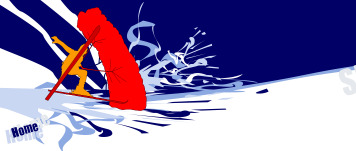BOOKS
THE GREAT BOOK OF AVIATION,
Weishaupt-Verlag, 1996, PARAGLIDING von Oliver Guenay
HOW IT ALL STARTED
Dan Poynter, an American, wrote two essential guides in 1972 and 1973. "Hanggliding - the Basic Handbook of Skysurfing" and "The Parachute Manual", in which he mentions square parachute launches in tow as well as square parachute foot launches on slopes. In parallel there was hardly any development in the German-speaking world, with two exceptions: Dieter Strasilla and Fritz Dolezalek. It was all about having oneself pulled up a slope by the wind using skis and some kind of airfoil. Strasilla called it "skisailing" and did not have a hunch about the development of the sport when he started out using round canopies in 1965. First attempts in slope soaring took place in St. Moritz / Engadin in winter in the so-called "Maloja wind" which offered ideal conditions.
Skisailing with a slotted round canopy from NASA stock (Dieter Strasilla at Georgy Glacier) Photos by Oliver Guenay
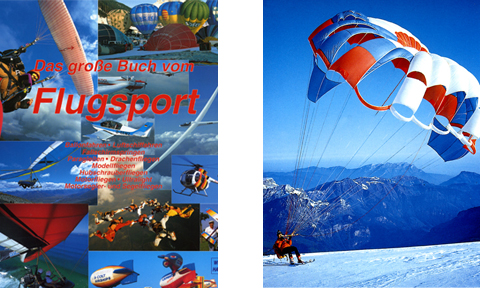
The round canopy used back then came from NASA stock (Strasilla's brother Udo was working there), but unlike (regular) parachute round canopies it was already made from spinnaker fabric (like modern paraglide sails / parafoils) and furnished with holes creating uplift. It came with ten bifurcated tethers and 3m long textile tubes close to the pilot in order to protect the tethers from the sharp edges of the skies.
By 1970 launches in tow, "Wächtenstarts" and slope soaring launches had been succesfully performed at Georgy Glacier / Piz Corvatsch using different round canopies between 20m2 and 40m2 in size. First short flights in strong wind came about by chance in the process. Strasilla had the round canopies made in England according to his own design; they were constructed in a way that in spite of their rate of descent of 4 m/sec one could slow them down to an extent that it became possible to touchdown in a standing position.
In the winter of 1970/71 Strasilla subsequently constructed a 18 m2 square parachute with five chambers and a minor aspect ratio. Parachute silk was used as fabric for this type and the chute was basically designed for sailling in strong wind with a pulling rod system (a prototype of the Skywing steering rod); the pilot in his harness was attached to a pivoted axel at its lower end. The first longer flight also came about that winter - once again by chance. The material was finally replaced by spinnaker fabric.
..................................................................
25 years ADVANCE: Anniversary book
THE PIONIEER
DIETER STRASILLA, born in 1943, was fascinated by flying from an early age.
Since the '60s the doctor of chemistry experimented in Switzerland with
modified round canopies. By chance he discovered their ability to glide and
developed the paraglider from them. Together with his brother he was the first
man to fly from the Jungfraujoch, 2676 metres down to Lauterbrunnen.
..................................................................
1973: "Skywing 11", the first paraglide
From 1973 to 1976 Strasilla constructed different types of rectangular chutes with seven and nine double chambers, similar to the square parachutes. Among those was probably the first paraglide ever (1973). The encounter with Andrea Kuhn in 1975 led to a fruitful cooperation in which Kuhn became a professional test pilot and an advisor improving Strasilla's concept of the Skywing steering rod (1976 patent). Experimental chutes with 11, 12, 13, 14 and 16 cells and a surface of up to 60 m2 were created between 1976 and 1978; Strasilla and Kuhn kept only the model with 11 cells. Strasilla's first summer foot launch with a Skywing 11 Chute took place at the Belchen in the Black Forest in May 1978. A little later in the same year the publicity would be created by others, though...
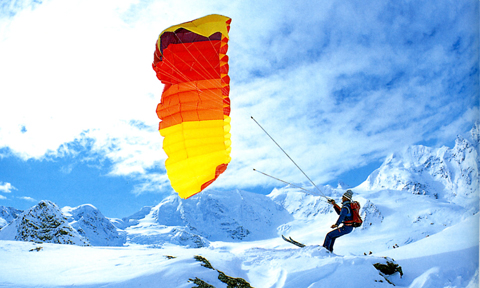
BOOK OF THE OLYMPICS - FASCINATION OF SPORT '82
proSport Verlag Munich
D.Strasilla vor Piz Bernina und Piz Palu
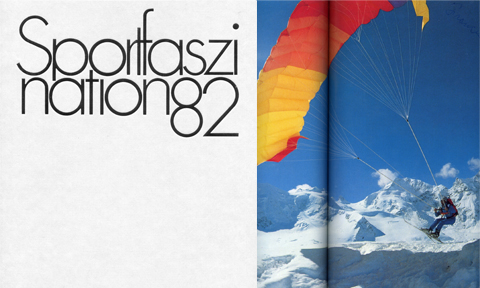
The fascination of flying
A dream of mankind returns ot its origins. Ever since technology made it possible to go supersonic by use of jet propulsion and to go up to the moon with the aid of rockets, sportspeople have preferred silent soaring and gliding. Kiteflying, gliding and balloon flying make sure man is closer to the fascination of bird flight and his own limit.
THE BIG BOOK OF SKI
Bruno Morawetz, Hoffmann and Campe, 1982, Piz
Bernina and Piz Palu
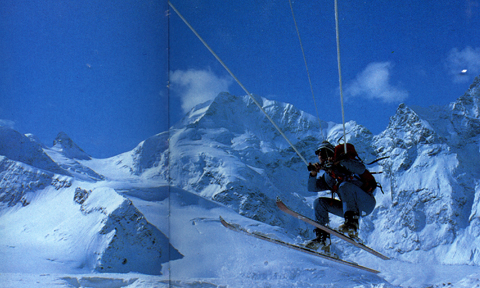
The wind is your partner, your strength. Dr. Dieter Strasilla has already confirmed this with a parachute; he had himself pulled uphill by the wind. Using this new, maneuverable airfoil sail he presented at the Diavolezza close to Pontresina in the spring of 1981, he can cruise like a glider, he can have himself pulled and lifted up, e.g. to cross crevasses. He does not need a lift or a cable car - only the wind.
